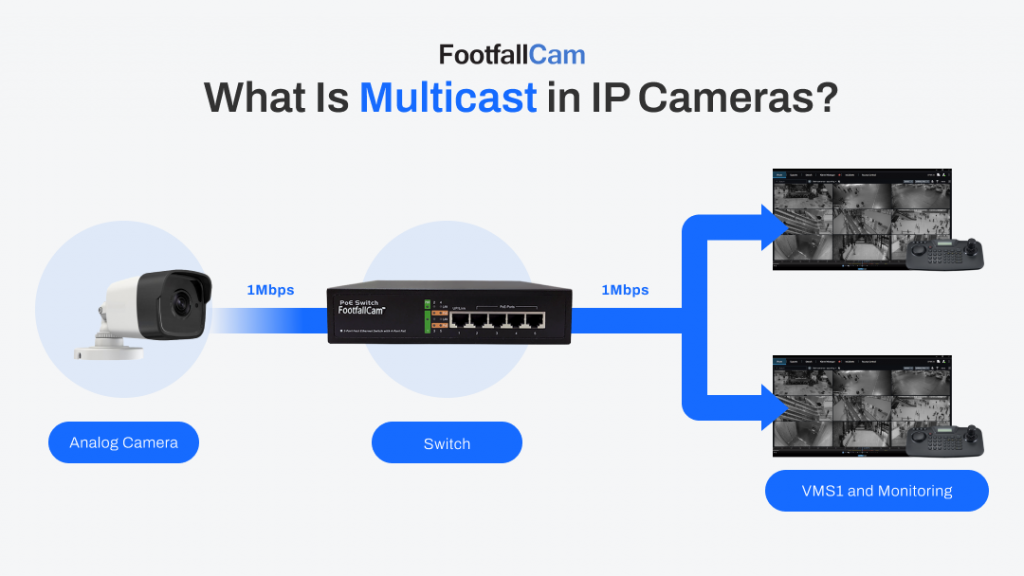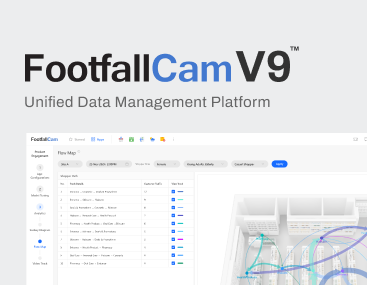
In the world of retail and commercial video surveillance, bandwidth is often one of the first concerns raised when expanding a CCTV setup—especially when adding advanced video analytics systems like the FootfallCam Centroid-48 or Centroid-16.
Fortunately, there’s a powerful, built-in solution that already exists in most IP cameras: multicast streaming.
What Is Multicast in IP Cameras?
Multicast is a network streaming protocol that allows one IP camera to broadcast its video stream to multiple destinations—such as a network video recorder (NVR) and a third-party analytics system—without duplicating the bandwidth usage.
Unlike unicast, where the camera sends a separate stream for each client, multicast sends one stream to the network switch, and any number of authorised clients can “tune in” to that stream. Think of it like a radio station that multiple listeners can access at the same time—no extra transmission power required.
Why This Matters for AI Video Analytics
Many businesses today are integrating AI video analytics platforms like FootfallCam’s Centroid series, which processes video feeds to extract metrics such as:
- People counting
- Queue analysis
- Dwell time
- Heatmaps of customer movement
Customers often ask:
“If I already have an NVR recording video from my IP cameras, won’t adding an analytics system double my network load?”
The answer is: not if you’re using multicast.
Real-World Example: Multicast in Action
Let’s say you’re using a typical Hikvision or Dahua IP camera—two of the most common brands globally. These cameras come with multicast support enabled or configurable via the camera web interface.
If you’re currently streaming one video feed to an NVR, your camera may be sending ~4 Mbps per stream. Without multicast, adding a second stream (e.g. for analytics) would double that to ~8 Mbps.
But with multicast, the same camera can stream just one multicast feed into the switch, and both the NVR and Centroid analytics system can receive it simultaneously, using no additional bandwidth.
That means:
✅ Your LAN remains stable
✅ No extra cabling or switches are needed
✅ Your network planning doesn’t need to change
✅ You’re fully prepared for advanced analytics upgrades with no surprises
How to Enable Multicast
- Login to your camera (Hikvision, Dahua, or other)
- Navigate to the Network → Advanced Settings → Multicast
- Enable multicast on the main or sub stream depending on your use case
- Ensure your network switch supports IGMP snooping (common in managed switches)
- Point both your NVR and Centroid to the same multicast IP address and port
And that’s it. No new bandwidth headaches.
Frequently Asked Questions (FAQ)
Q1: Do all IP cameras support multicast?
A: Most modern IP cameras—even entry-level models from Hikvision, Dahua, Uniview—support multicast. Check the specs or web interface to confirm.
Q2: Will multicast affect my NVR recording?
A: No. Your NVR will continue to receive the stream as usual. Multicast simply allows other systems (like Centroid) to listen in without adding load.
Q3: Do I need a special switch for multicast?
A: Ideally, yes. Managed switches with IGMP snooping are recommended for multicast to function efficiently. Many enterprise and commercial-grade switches support this.
Q4: Can I use multicast with Centroid-16 or Centroid-48?
A: Absolutely. FootfallCam Centroid units are fully compatible with multicast and will auto-detect and configure to use it when available.
Q5: What if I can’t enable multicast on my cameras?
A: The system can still work in unicast mode, but your network must be sized to handle the additional stream per camera.
Conclusion
With multicast, you don’t have to choose between your existing CCTV system and your desire for smarter insights. By leveraging a feature your cameras likely already support, you can upgrade to FootfallCam’s Centroid series with confidence—knowing that your network bandwidth won’t be compromised.
Want to learn more? Contact us to schedule a quick site assessment or to explore our Centroid analytics platform in action.
#footfallcam #peoplecounter #peoplecounting #retail #smartretail #aianalytics #multicaststreaming #CCTV #bandwidthoptimisation











